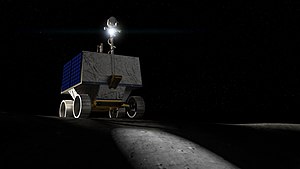
Back فايبر (متجول) Arabic VIPER Spanish وایپر (ماهنورد) Persian VIPER (astromobile) French VIPER (רובר) HE Viper Hungarian VIPER Polish VIPER (луноход) Russian VIPER Ukrainian
 Artist's impression of VIPER operating in darkness. | |
| Names | Volatiles Investigating Polar Exploration Rover |
|---|---|
| Mission type | Exploration, resource prospecting |
| Operator | NASA |
| Website | https://www.nasa.gov/viper |
| Mission duration | 100 days (planned)[1][2][3] |
| Spacecraft properties | |
| Spacecraft type | Robotic lunar rover |
| Manufacturer | NASA Ames Research Center |
| Dry mass | 430 kg (950 lb)[4] |
| Dimensions | 2.45 m (8 ft 0 in) in height, 1.53 m (5 ft 0 in) in length and width[5] |
| Start of mission | |
| Launch date | November 2024 (planned)[6][needs update?] |
| Rocket | Falcon Heavy |
| Launch site | Kennedy Space Center, LC-39A |
| Contractor | SpaceX |
| Moon rover | |
| Landing date | November 2024[needs update?] |
| Landing site | Mons Mouton, South pole region[7][2] |
| Instruments | |
| Neutron Spectrometer System (NSS) Near InfraRed Volatiles Spectrometer System (NIRVSS) The Regolith and Ice Drill for Exploring New Terrain (TRIDENT) Mass Spectrometer Observing Lunar Operations (MSolo) | |
VIPER (Volatiles Investigating Polar Exploration Rover) is a lunar rover developed by NASA (Ames Research Center), and currently planned to be delivered to the surface of the Moon in November 2024.[6][needs update?]The rover will be tasked with prospecting for lunar resources in permanently shadowed areas in the lunar south pole region, especially by mapping the distribution and concentration of water ice. The mission builds on a previous NASA rover concept called Resource Prospector, which was cancelled in 2018.[8]
On 11 June 2020, NASA awarded Astrobotic Technology of Pittsburgh, Pennsylvania, US$199.5 million to launch VIPER to the lunar south pole. VIPER will be carried aboard Astrobotic's Griffin lander as part of NASA's Commercial Lunar Payload Services (CLPS) initiative. Astrobotic is responsible for end-to-end services for delivery of VIPER, including integration with its Griffin lander, launch from Earth, and landing on the Moon.[9]

- ^ Cite error: The named reference
Crunch Oct2019was invoked but never defined (see the help page). - ^ a b Cite error: The named reference
Loff Oct2019was invoked but never defined (see the help page). - ^ Cite error: The named reference
Bartells Oct2019was invoked but never defined (see the help page). - ^ Colaprete, Anthony (17 August 2020). "VIPER: A lunar water reconnaissance mission" (PDF). NASA. Retrieved 25 August 2020.
 This article incorporates text from this source, which is in the public domain.
This article incorporates text from this source, which is in the public domain.
- ^ "NASA's Next Lunar Rover Progresses Toward 2023 Launch". NASA. 24 February 2021. Retrieved 5 March 2021.
 This article incorporates text from this source, which is in the public domain.
This article incorporates text from this source, which is in the public domain.
- ^ a b "NASA Replans CLPS Delivery of VIPER to 2024 to Reduce Risk". NASA. 18 July 2022. Retrieved 18 July 2022.
- ^ Wright, Ernie; Ladd, David; Colaprete, Anthony; Ladd, David (20 September 2021). "NASA Scientific Visualization Studio". SVS. Retrieved 27 October 2023.
- ^ Bartels, Meghan (16 October 2019). "Moon VIPER: NASA Wants to Send a Water-Sniffing Rover to the Lunar South Pole in 2022". Space.com. Retrieved 13 April 2021.
- ^ "NASA Selects Astrobotic to Fly Water-Hunting Rover to the Moon". NASA. 11 June 2020. Retrieved 14 June 2020.
 This article incorporates text from this source, which is in the public domain.
This article incorporates text from this source, which is in the public domain.
© MMXXIII Rich X Search. We shall prevail. All rights reserved. Rich X Search